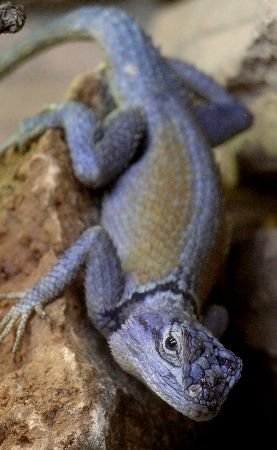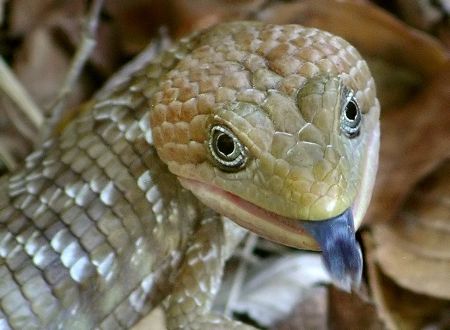October, 2011
Blue Lizards
by Valerie
When kids are given coloring books, they often use a standard palette for various images. Apples are red (so much for Granny Smith greens and Yellow Delicious), leaves are green (it is never autumn), and the sun is yellow (most people don't realize it is actually white because they cannot look directly at it when it is right overhead). For some reason, alligators are often colored green, when they are never that hue in real life. Lizards, of course, are sometimes green, and they look a bit like alligators, so that is probably where the confusion arises.
 In the natural world, green is quite common; it is, after all, the color of chlorophyll, which most plants have in abundance. There are also plenty of browns, the color of dirt, tree trunks, and most mammals. Flowers are frequently yellow, orange, or red, as are many butterflies. Blue is most encompassing as the color of the sky and water, which accounts for a large part of our environment. But on animals and plants, blue is rather scarce. There are blue flowers, but many are tinged with red, being more purple. Whoever first chanted, "Roses are red and violets are blue" must have been a poor observer of nature. Some birds are blue, and there is even a mammal, the Mandrill, that has patches of blue skin. If you are not convinced that blue is special, just watch people in an exotic butterfly flight display. They enjoy the red, yellow and orange butterflies that dominate the population. But when a Blue Morpho sails past, all eyes follow. It is strikingly different from the majority, and therefore much admired.
In the natural world, green is quite common; it is, after all, the color of chlorophyll, which most plants have in abundance. There are also plenty of browns, the color of dirt, tree trunks, and most mammals. Flowers are frequently yellow, orange, or red, as are many butterflies. Blue is most encompassing as the color of the sky and water, which accounts for a large part of our environment. But on animals and plants, blue is rather scarce. There are blue flowers, but many are tinged with red, being more purple. Whoever first chanted, "Roses are red and violets are blue" must have been a poor observer of nature. Some birds are blue, and there is even a mammal, the Mandrill, that has patches of blue skin. If you are not convinced that blue is special, just watch people in an exotic butterfly flight display. They enjoy the red, yellow and orange butterflies that dominate the population. But when a Blue Morpho sails past, all eyes follow. It is strikingly different from the majority, and therefore much admired.
Reptiles are mostly a drab lot. Alligators are predominantly black and brownish. Turtles are also mostly brown, with a few red or yellow decorations. Snakes and lizards must hide from predators, so they often have handsomely patterned scales in shades of brown that make them disappear in their terrestrial habitats. But, as the saying goes, there are exceptions to every rule. Take, for example, the color blue on lizards.
A good place to see blue lizards is the zoo. With a worldwide fauna to choose from, most zoos attempt to display the showiest animals they can obtain. The Blue Mountain Swift (Sceloporus minor) comes from Mexico. The males have the azure tint while females are cryptically colored, so it is a show-off feature, sort of like a peacock's tail. It doesn't help the animal escape predators but does impress potential mates. A male that can survive in spite of advertising his presence must be VERY fit.
We don't have any all-blue lizards here in our area, but that doesn't mean the color is absent. Males of the Northern Fence Lizard (Sceloporus undulatus hyacinthinus), which is closely related to the Blue Mountain Swift, have turquoise patches on their bellies and chins. Just enough color to attract females but it is not visible to predators above. It's not that our species is less daring than the Mexican one, but that habitat differences make it possible for the latter to survive even when it is more conspicuous.
The most beautiful blue color on any lizard is found on the tail of the Five-lined Skink (Eumeces fasciatus). Only young lizards have this feature; the color fades in adulthood to a uniform brown. The tail is easily broken off and will grow back, so the color is to distract predators to that expendable part of the animal.
There is one more example to be mentioned, and it is quite a surprise. I have never read or heard about this feature, but saw it myself when I was photographing a Texas Alligator Lizard (Gerrhonotus liocephalus infernalis) here in Austin. The animal has no blue on its scales like the previously mentioned species; it is slow-moving and relies on camouflage for protection. If it is threatened, as it felt it was by my camera lens, the reptile will inflate its body to make it bigger and harder to swallow. The lizard's heavy plate-like scales also offer some defense. If these deterrents are not enough, the Alligator Lizard has one more trick up its sleeve. Because I wasn't put off by the impressive display up to that point, it performed its scariest act yet: it stuck out a blue tongue!

 In the natural world, green is quite common; it is, after all, the color of chlorophyll, which most plants have in abundance. There are also plenty of browns, the color of dirt, tree trunks, and most mammals. Flowers are frequently yellow, orange, or red, as are many butterflies. Blue is most encompassing as the color of the sky and water, which accounts for a large part of our environment. But on animals and plants, blue is rather scarce. There are blue flowers, but many are tinged with red, being more purple. Whoever first chanted, "Roses are red and violets are blue" must have been a poor observer of nature. Some birds are blue, and there is even a mammal, the Mandrill, that has patches of blue skin. If you are not convinced that blue is special, just watch people in an exotic butterfly flight display. They enjoy the red, yellow and orange butterflies that dominate the population. But when a Blue Morpho sails past, all eyes follow. It is strikingly different from the majority, and therefore much admired.
In the natural world, green is quite common; it is, after all, the color of chlorophyll, which most plants have in abundance. There are also plenty of browns, the color of dirt, tree trunks, and most mammals. Flowers are frequently yellow, orange, or red, as are many butterflies. Blue is most encompassing as the color of the sky and water, which accounts for a large part of our environment. But on animals and plants, blue is rather scarce. There are blue flowers, but many are tinged with red, being more purple. Whoever first chanted, "Roses are red and violets are blue" must have been a poor observer of nature. Some birds are blue, and there is even a mammal, the Mandrill, that has patches of blue skin. If you are not convinced that blue is special, just watch people in an exotic butterfly flight display. They enjoy the red, yellow and orange butterflies that dominate the population. But when a Blue Morpho sails past, all eyes follow. It is strikingly different from the majority, and therefore much admired.

